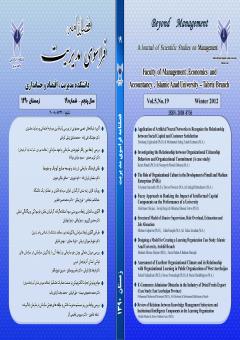رویکرد فازی رتبه بندی اثرگذاری اجزای سرمایه فکری بر عملکرد یک دانشگاه
محورهای موضوعی : مدیریت بازرگانیعبدالناصر شجاعی 1 , تورج بیگی 2 * , محمدحسن فطرس 3
1 - دانشجوی دکتری، عضو هیأت علمی دانشگاه آزاد اسلامی واحد سنندج
2 - دانشجوی دکترای اقتصاد دانشگاه آزاد اسلامی واحد علوم و تحقیقات
3 - عضو هیات علمی (دانشیار) دانشگاه بوعلی سینای همدان ، همدان ، ایران
کلید واژه: عملکرد, سرمایه فکری, تحلیل سلسله مراتبی فازی, دانشگاه,
چکیده مقاله :
داراییهای نامشهود بیانگر تمام داراییهایی هستند که در ترازنامه منعکس نمی شوند، اما منبعی برای خلق ارزش محسوب شده که منجر به مزیت رقابتی پایدار می شوند.در اقتصاد نوین، سرمایه فکری تحت عنوان داراییهای نامشهود توصیف شده است که میتوان آن را به عنوان منبعی برای مزیت رقابتی پایدار به کار گرفت تا جایی که سازمانهای پیشرو در اقتصاد مدرن آنهایی هستند که با اتکاء به سرمایه فکری به خلق ارزش میپردازند. از طرف دیگر دانشگاه ها نیز این قاعده مستثنی نیستند و افزایش عملکرد دانشگاهها یکی از اصلی ترین اهداف هر کشور در جهت نیل به رشد و توسعه ی پایدار می باشد. در این مطالعه سعی بر آن است که با استفاده از تحلیل سلسله مراتبی فازی به رتبه بندی اثرگذاری هریک از اجزای سرمایه فکری بر عملکرد دانشگاه پرداخته شود. در گام اول پرسشنامه ای مشتمل بر 7 جدول توسط 9 نفر از مدیران موفق و پژوهشگران برتر دانشگاه تنظیم شد و بر اساس روش چانگ تحلیل سلسله مراتبی فازی صورت گرفت. نتایج رتبه بندی فازی بیانگر آن است که درجه اثرگذاری اجزای سرمایه فکری بر عملکرد سازمانی به ترتیب از کانال اعضای هیات علمی(تعداد و رتبه اساتید)، ارتباط با بازار و صنعت، زیرساختهای IT، ارتباط با دولت، کارکنان و زیر ساختهای فیزیکی می باشد.
Intangible assets represent all assets that are not reflected in the balance sheet but are considered a source for creating value that leads to sustainable competitive advantages. In the modern economy, intellectual capital is described as an intellectual asset that can be used as a source for sustainable competitive advantage so much so that the leading organizations in modern economy are those that create value by relying on intellectual capital. On the other hand, universities face the same challenges, and increasing the performance of universities is one of the major goals of every country to achieve sustainable growth and development. In this study, we have applied fuzzy hierarchical analysis to the ranking of the effect of each intellectual capital component on the performance of universies. In the first step, a questionnaire consisting of 7 tables was set by 9 successful managers and top university researchers, and the hierarchical fuzzy analysis was carried out on the basis of Chang method. The results of fuzzy ranking indicate that the degree of the influence of intellectual capital components on the organizational performance is determined by the number and rank of the academic staff, relation with the market and industry, IT infrastructures, relation with government, staff, and physical infrastructures, respectively.

